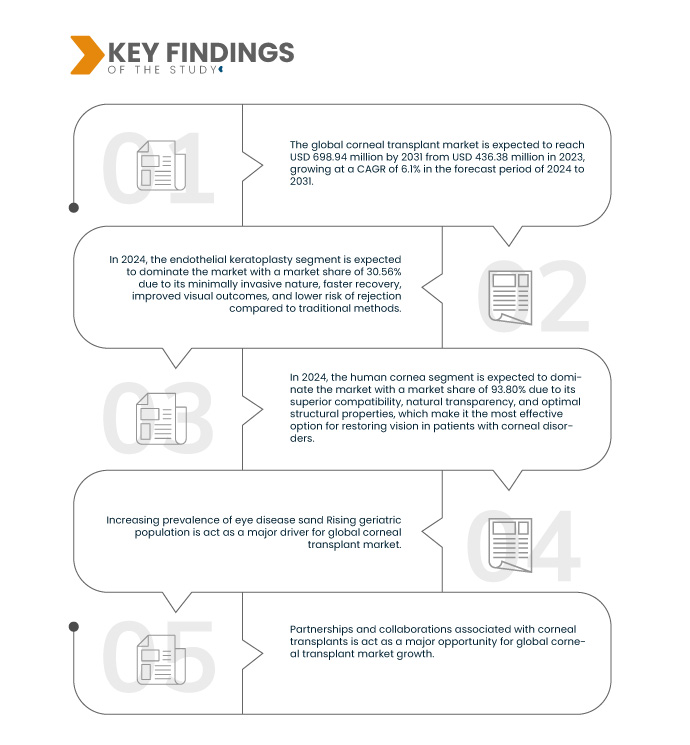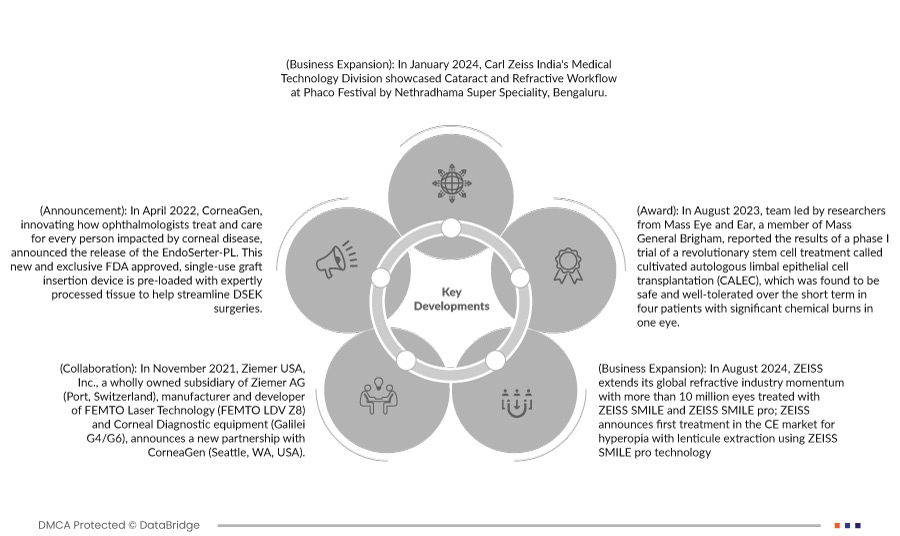The increasing prevalence of eye diseases is a significant driver in the global corneal transplant market, as conditions like keratoconus treatment, Fuchs' endothelial dystrophy, and corneal scarring due to infections or trauma are becoming more common. These diseases can lead to severe vision impairment or blindness, prompting a growing demand for corneal transplants as a restorative treatment. The rise in eye disorders is often linked to factors such as aging populations, higher rates of diabetes, and increased exposure to environmental pollutants and UV radiation, which can damage the cornea. Also, advancements in diagnostic techniques are leading to earlier detection of these diseases, allowing for timely interventions, including corneal transplantation. Furthermore, greater awareness of corneal health and the availability of improved surgical techniques, such as Descemet's Membrane Endothelial Keratoplasty (DMEK) and Descemet's Stripping Automated Endothelial Keratoplasty (DSAEK), are contributing to the growing acceptance of corneal transplants. As the burden of eye diseases continues to grow worldwide, the need for effective solutions like corneal transplants is expected to rise, fueling market growth.
The rising geriatric population is a key driver in the Global Corneal Transplant Market, as older adults are more susceptible to various eye conditions that can lead to corneal damage and the need for transplants. Age-related eye diseases, such as Fuchs' endothelial dystrophy, bullous keratopathy, and other degenerative corneal disorders, become more prevalent with advancing age, significantly increasing the demand for corneal transplants. Also, older adults are more likely to experience complications from cataract surgery or develop chronic conditions like diabetes, which can further contribute to corneal deterioration. As the global population ages, the number of individuals requiring corneal transplants is expected to rise, particularly in regions with rapidly aging demographics. This trend is further fueled by increased awareness about the availability and success rates of corneal transplants, as well as advancements in surgical techniques that offer better outcomes and faster recovery times for older patients. As a result, the growing geriatric population is a major factor driving the expansion of the global corneal transplant market, highlighting the need for accessible and effective treatment options for age-related corneal diseases.
Access Full Report @ https://www.databridgemarketresearch.com/ar/reports/global-corneal-transplant-market
Data Bridge Market Research analyzes that the Global Corneal Transplant Market is expected to reach USD 698.94 million by 2031 from USD 436.38 million in 2023, growing with a CAGR of 6.1% in the forecast period of 2024 to 2031. The endothelial keratoplasty segment is expected to dominate the market due to its minimally invasive nature, faster recovery, improved visual outcomes, and lower risk of rejection compared to traditional methods.
Key Findings of the Study
- Technological Advancements In Corneal Implants
Technological advancements in corneal implants are a significant driver of the global corneal transplant market, as they have greatly improved the safety, efficacy, and accessibility of these procedures. Innovations such as the development of advanced synthetic corneal implants, like artificial corneas or keratoprostheses, have expanded treatment options for patients who are not suitable candidates for traditional donor corneal transplants. Moreover, improved surgical techniques, such as minimally invasive procedures and laser-assisted surgeries, have reduced recovery times, minimized complications, and enhanced overall surgical outcomes. These advancements have also led to a better understanding of corneal biomechanics and tissue engineering, enabling the creation of bioengineered corneas that closely mimic natural tissue. Also, technological improvements in imaging and diagnostic tools, like Optical Coherence Tomography (OCT) and high-resolution corneal mapping, allow for more precise assessments and personalized treatment plans, further boosting the success rates of corneal transplants. Together, these innovations are making corneal transplant surgeries safer, more effective, and accessible to a broader range of patients, thereby driving the growth of the global corneal transplant market.
Report Scope and Market Segmentation
|
Report Metric
|
Details
|
|
Forecast Period
|
2024 to 2031
|
|
Base Year
|
2023
|
|
Historic Years
|
2022 (Customizable 2016-2021)
|
|
Quantitative Units
|
Revenue in USD Million
|
|
Segments Covered
|
Procedure Type (Endothelial Keratoplasty, Penetrating Keratoplasty, Anterior Lamellar Keratoplasty (ALK), Corneal Limbal Stem Cell Transplant, Artificial Cornea Transplant, and Others), Type (Human Cornea and Synthetic), Donor Type (Autograft and Allograft), Graft Type (Partial Thickness Grafts (Lamellar) and Full Thickness Grafts (Penetrating)), Surgery Type (Conventional Surgery, Laser-Assisted Surgery), Indication (Fuch's Endothelial Dystrophy, Infectious Keratitis, Bullous Keratopathy, Keratoconus, Regraft Procedures, Corneal Scarring, Corneal Ulcers, and Others), Gender (Female and Male), Age Group (Geriatric, Adult, and Pediatric), End User (Hospitals, Eye Clinics, Ambulatory Surgical Centers, Academic & Research Institutes, and Others)
|
|
Countries Covered
|
U.S., Canada, Mexico, Germany, France, U.K., Italy, Spain, Russia, Netherlands, Switzerland, Turkey, Belgium, Denmark, Norway, Sweden, Poland, Rest of Europe, Brazil, Argentina, Rest of South America, China, India, Japan, Australia, South Korea, Singapore, Philippines, Malaysia, Indonesia, Thailand and Rest of Asia-Pacific, South Africa, Saudi Arabia, U.A.E., Egypt, Israel, Rest of Middle East and Africa
|
|
Market Players Covered
|
ZEISS Group (Carl Zeiss Meditec AG.)(Germany), Alcon(Switzerland), CorneaGen(U.S.), Ziemer Ophthalmic Systems AG(Europe), RUMEX International Co.(U.S.), AJL Ophthalmic S.A.(Spain), OCL Vision(U.K), San Diego Eye Bank(U.S.), Ovation International(India), Massachusetts Eye and Ear(U.S.), Florida Lions Eye Bank(U.S.), CorNeat Vision(Israel) and KeraMed, Inc. (U.S.)
|
|
Data Points Covered in the Report
|
In addition to the insights on market scenarios such as market value, growth rate, segmentation, geographical coverage, and major players, the market reports curated by the Data Bridge Market Research also include depth expert analysis, patient epidemiology, pipeline analysis, pricing analysis, and regulatory framework.
|
Segment Analysis
Global corneal transplant market is categorized into nine notable segments which are based on procedure type, type, donor type, graft type, surgery type, indication, gender, age group, and end user.
- Based on procedure type, the market is segmented into endothelial keratoplasty, penetrating keratoplasty, Anterior Lamellar Keratoplasty (ALK), corneal limbal stem cell transplant, artificial cornea transplant, and others.
In 2024, the endothelial keratoplasty segment is expected to dominate the global corneal transplant market
In 2024, the endothelial keratoplasty segment is expected to dominate the market with a market share of 30.56% due to its minimally invasive nature, faster recovery, improved visual outcomes, and lower risk of rejection compared to traditional methods.
- Based on type, the market is segmented into human cornea and synthetic
In 2024, the human cornea segment is expected to dominate the global corneal transplant market
In 2024, the human cornea segment is expected to dominate the market with a market share of 93.80% due to its superior compatibility, natural transparency, and optimal structural properties, which make it the most effective option for restoring vision in patients with corneal disorders.
- Based on donor type, the market is segmented into allograft and autograft. In 2024, the allograft segment is expected to dominate the market with a market share of 94.24%
- Based on graft type, the market is segmented into partial thickness grafts (lamellar), full thickness grafts (penetrating). In 2024, the partial thickness grafts (lamellar) segment is expected to dominate the market with a market share of 64.60%
- Based on surgery type, the market is segmented into conventional surgery and laser-assisted surgery. In 2024, the conventional surgery segment is expected to dominate the market with a market share of 61.14%
- Based on indication, the market is segmented into fuch's endothelial dystrophy, infectious keratitis, bullous keratopathy, keratoconus, regraft procedures, corneal scarring, corneal ulcers and others. In 2024, the fuch's endothelial dystrophy segment is expected to dominate the market with a market share of 24.35%
- Based on gender, the market is segmented into female and male. In 2024, the female segment is expected to dominate the market with a market share of 51.65%
- Based on age group, the market is segmented into geriatric, adult and paediatrician 2024, the geriatric segment is expected to dominate the market with a market share of 55.75%
- Based on end user, the market is segmented into hospitals, eye clinics, ambulatory surgical centres, academic & research institutes and others. In 2024, the hospitals segment is expected to dominate the market with a market share of 37.22%
Major Players
Data Bridge Market Research analyses ZEISS Group (Carl Zeiss Meditec AG.) (Germany), Alcon (Switzerland), CorneaGen (U.S.), Ziemer Ophthalmic Systems AG (Europe), RUMEX International Co. (U.S.) as the major player operating in the market.
Market Development
- In August 2024, ZEISS extends its global refractive industry momentum with more than 10 million eyes treated with ZEISS SMILE and ZEISS SMILE pro; ZEISS announces first treatment in the CE market for hyperopia with lenticule extraction using ZEISS SMILE pro technology
- In January 2024, Carl Zeiss India's Medical Technology Division showcased Cataract and Refractive Workflow at Phaco Festival by Nethradhama Super Speciality, Bengaluru. At the Phaco Festival, the spotlight shined on ZEISS's transformative impact on the Cataract and Corneal Refractive Workflows
- In June 2024, CorneaGen today announces the commercial launch of Corneal Tissue Addition for Keratoplasty (CTAK), an innovative and extremely effective solution to corneal contouring for keratoconic eyes. Developed by CorneaGen in partnership with CTAK LLC and Ziemer, CTAK provides patient ready, gamma-irradiated sterile, non-immunogenic corneal tissue segments, laser cut and customized to patients’ specific cone severity and location
- In January 2024, Seattle-based CorneaGen is excited to announce an expansion of their eye recovery services throughout northern and southern California. Through this expansion of service, CorneaGen will now provide both eye recovery and processing services of donor tissue for facilities throughout the state, resulting in an even better experience for the patients, families, and staff of their California partner facilities
Regional Analysis
Geographically, the countries covered in the global corneal transplant market report U.S., Canada, Mexico, Germany, France, U.K., Italy, Spain, Russia, Netherlands, Switzerland, Turkey, Belgium, Denmark, Norway, Sweden, Poland, rest of Europe, Brazil, Argentina, rest of South America, China, India, Japan, Australia, South Korea, Singapore, Philippines, Malaysia, Indonesia, Thailand and rest of Asia-Pacific, South Africa, Saudi Arabia, U.A.E., Egypt, Israel, rest of Middle East and Africa.
As per Data Bridge Market Research analysis:
North America is expected to dominate the global corneal transplant market
North America is expected to dominate the market due to factors like high prevalence of infections, advanced healthcare infrastructure, strong consumer awareness and purchasing power, ongoing research and development initiatives, established marketing and distribution networks.
Asia-Pacific is expected to be the fastest growing region in the global corneal transplant market
Asia-Pacific is expected to be the fastest growing region in the market due to its large population, increasing healthcare spending, expanding pharmaceutical industry, growing consumer awareness, and demand for treatments, coupled with a developing healthcare infrastructure and a rising prevalence.
For more detailed information about the global corneal transplant market, click here – https://www.databridgemarketresearch.com/ar/reports/global-corneal-transplant-market














